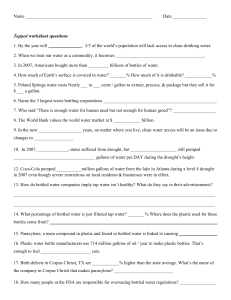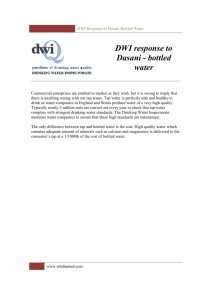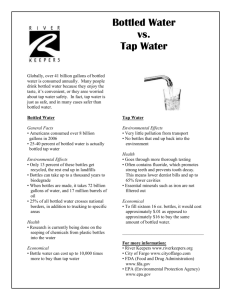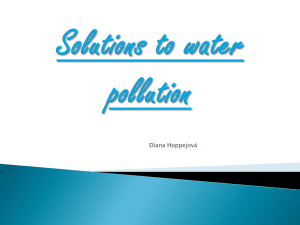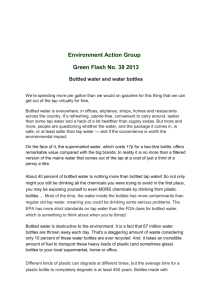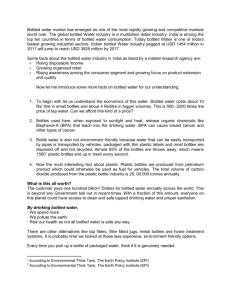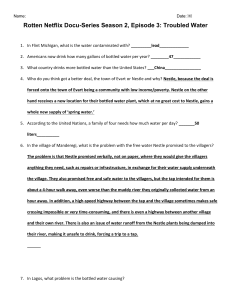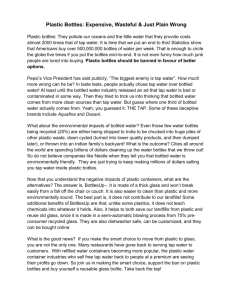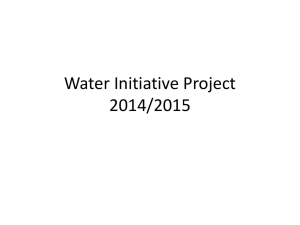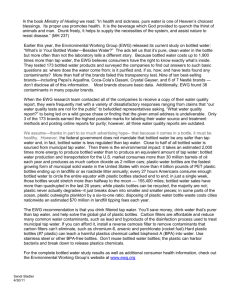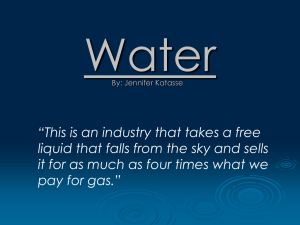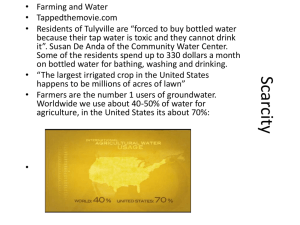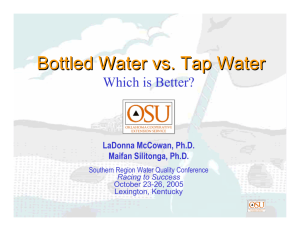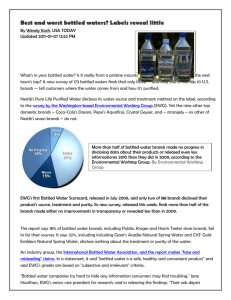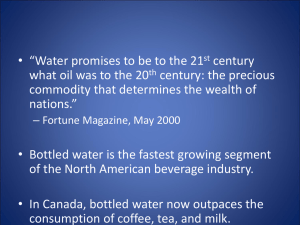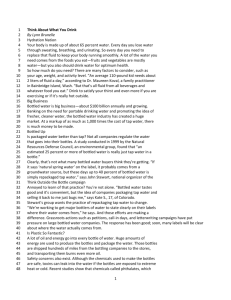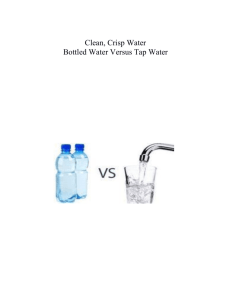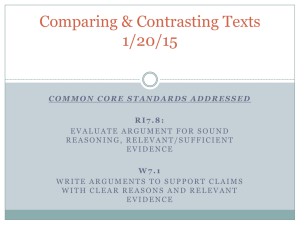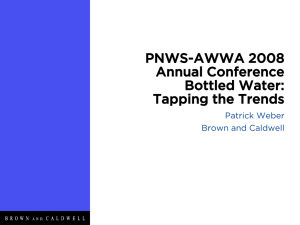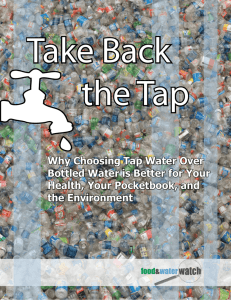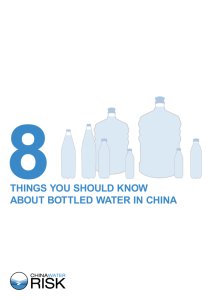Tapped: The Movie - Teacher's Guide
advertisement
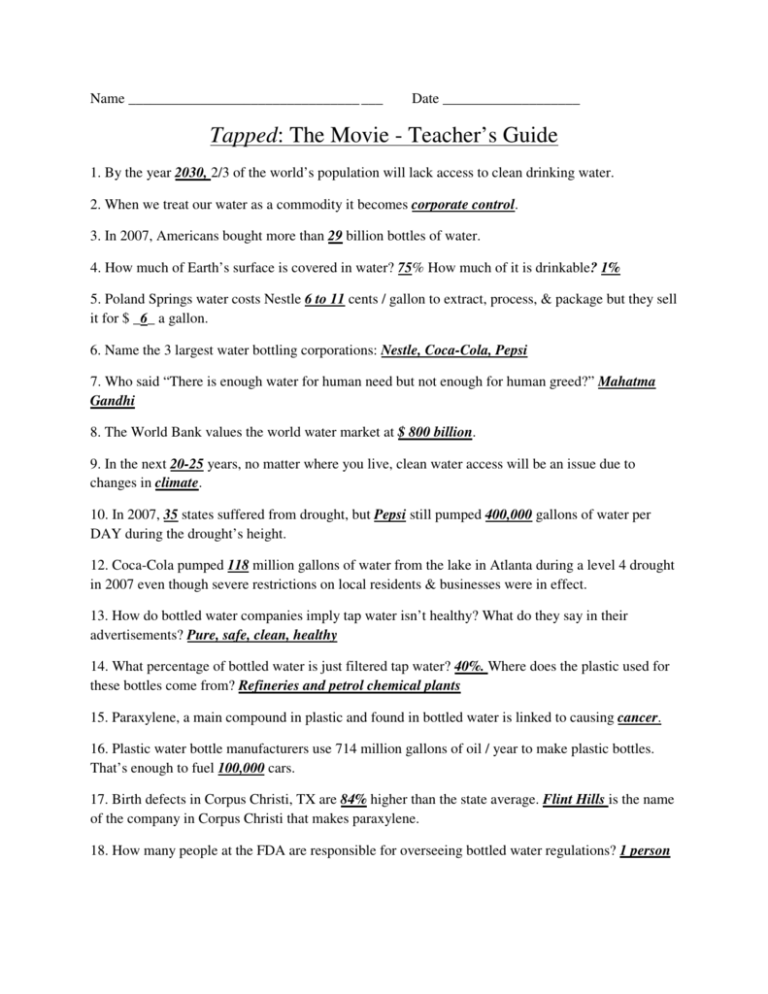
Name ________________________________ ___ Date ___________________ Tapped: The Movie - Teacher’s Guide 1. By the year 2030, 2/3 of the world’s population will lack access to clean drinking water. 2. When we treat our water as a commodity it becomes corporate control. 3. In 2007, Americans bought more than 29 billion bottles of water. 4. How much of Earth’s surface is covered in water? 75% How much of it is drinkable? 1% 5. Poland Springs water costs Nestle 6 to 11 cents / gallon to extract, process, & package but they sell it for $ _6_ a gallon. 6. Name the 3 largest water bottling corporations: Nestle, Coca-Cola, Pepsi 7. Who said “There is enough water for human need but not enough for human greed?” Mahatma Gandhi 8. The World Bank values the world water market at $ 800 billion. 9. In the next 20-25 years, no matter where you live, clean water access will be an issue due to changes in climate. 10. In 2007, 35 states suffered from drought, but Pepsi still pumped 400,000 gallons of water per DAY during the drought’s height. 12. Coca-Cola pumped 118 million gallons of water from the lake in Atlanta during a level 4 drought in 2007 even though severe restrictions on local residents & businesses were in effect. 13. How do bottled water companies imply tap water isn’t healthy? What do they say in their advertisements? Pure, safe, clean, healthy 14. What percentage of bottled water is just filtered tap water? 40%. Where does the plastic used for these bottles come from? Refineries and petrol chemical plants 15. Paraxylene, a main compound in plastic and found in bottled water is linked to causing cancer. 16. Plastic water bottle manufacturers use 714 million gallons of oil / year to make plastic bottles. That’s enough to fuel 100,000 cars. 17. Birth defects in Corpus Christi, TX are 84% higher than the state average. Flint Hills is the name of the company in Corpus Christi that makes paraxylene. 18. How many people at the FDA are responsible for overseeing bottled water regulations? 1 person 19. FDA has no control over INstate commerce, only INTERstate (crossing state lines). Ex: If water pumped in Maine and dispensed in Maine is NOT regulated by the FDA. How much bottled water purchased is produced within state lines? 60% to 70% 20. Bottled water manufacturers do their own tests on sources & products. Are they required to submit these reports to the FDA? No. Municipal water sources also test their water sources & products. Are they required to submit these reports? Yes 21. Municipalities test tap water multiple times per day. In a city of over 1 million, they test tap water 300 times per month. In a city of over 3 million, they test tap water 400 times per month. 22. B-phisenol or BPA is linked to many severe health problems. Name 3: Diabetes, obesity, breast cancer, prostate cancer, brain and liver disease, low sperm count. 23. National Institutes of Health reviewed over 700 peer-reviewed studies on BPA. FDA reviewed 2 studies from the industry. 38 internationally recognized scientists expressed concern over BPA’s effect on human health. 24. Dr. Alderson states that all approval from FDA comes from whose studies? What does this mean? Ex: If approval comes from only one source, there is a higher chance of providing information which solely substantiates their argument. Industry studies ________________________________________________________________________ 25. Of 80 million single serving plastic bottles used daily, ___30___ million end up in landfills. 26. The average world recycling of beverage containers is 50%. The US is 20%. 27. Eleven states have container deposit legislation. The 5¢ states have a 70% return rate while Michigan with its 10¢ deposit has 97% return rate. 28. 50% of Americans don’t have curbside recycling yet bottled water companies push that method of recycling over container deposit legislation. 29. In 1999, the Western Pacific Garbage Patch had 6 times the plastic as plankton. In 2008, that had jumped to 46 times. 30. Name 3 things listed in the credits that YOU can do (e.g., Vote with your dollar, Be mindful of your own water usage, Demand that bottled water companies make water quality reports available to the public, etc.). _________________________________________________________________________________ _________________________________________________________________________________ _________________________________________________________________________________ Additional activities and bonus questions: These are optional bonus questions that you can choose to use. If you choose to use these bonus questions, write them on the board and have students answer them at the bottom of their answer sheet under #30. Bonus Questions: 1. Where is the largest food processing plant in the world? __________________________ 2. Poland Springs is a part of which major corporation? _____________________________ 3. What country is this corporation from?_______________________________________ 4. Why are local residents so upset about Nestle’s water mining? (at least 3 reasons) Is the anger of these local residents justified? a. b. c. Activity based on information in Extras- World Water Crisis Tell students that they are going to use some of the class’s answers to question #30 for a debate. Call on a few students to share their responses to question #30 and write the responses on the board. Take a poll and the two responses with the most hands will be the topic of debate- each team in advocates why their response is best to implement in their local community. Have them think about: The needs of residents, ability of residents, environment, available resources, tools used to implement ideas such as communicating with local legislators etc. *If there is extra time you can pose the statement to the class: Safe drinking water and water sanitation is the number one health crisis around the world. Every 15 seconds a child dies from preventable water borne disease. Ask for basic feedback and form a discussion about what we can do as a community and as individuals.
